
About UsThe Numismatic Bibliomania Society is a non-profit organization promoting numismatic literature. For more information please see our web site at coinbooks.org SubscriptionsThose wishing to become new E-Sylum subscribers (or wishing to Unsubscribe) can go to the following web page link MembershipThere is a membership application available on the web site Membership Application To join, print the application and return it with your check to the address printed on the application. Membership is only $15 to addresses in the U.S., $20 for First Class mail, and $25 elsewhere. For those without web access, write to: David M. Sundman, Treasurer AsylumFor Asylum mailing address changes and other membership questions, contact David at this email address: dsundman@LittletonCoin.com SubmissionsTo submit items for publication in The E-Sylum, just Reply to this message, or write to the Editor at this address: whomren@gmail.com
BUY THE BOOK BEFORE THE COIN |
- WAYNE'S WORDS: THE E-SYLUM OCTOBER 27, 2013
- LAKE BOOKS MAIL-BID SALE #116 CLOSES OCTOBER 29, 2013
- HARDCOVER FORD PARTS 22, 23, 24 CATALOGS AVAILABLE
- NEW BOOK: GUIDE BOOK OF U.S. COINS, PROFESSIONAL EDITION, 5TH EDITION
- NEW BOOK: THE LOS AUSTRIAS COPPERS (1516-1700)
- NEW BOOK: COINS AND JETONS OF FRENCH INDOCHINA
- BOOK REVIEW: PANIC SCRIP OF 1893, 1907 AND 1914
- BOOK REVIEW: HEATH’S COUNTERFEIT DETECTOR, 11TH EDITION
- READERS REMEMBER GEORGE J. FULD
- NOTES FROM E-SYLUM READERS: OCTOBER 27, 2013
- SOME IMAGES FROM PABITRA SAHA: OCTOBER 27, 2013
- TURN YOUR SMARTPHONE INTO A COIN MICROSCOPE
- SELECTIONS FROM THE NOVEMBER 16, 2013 CHARLES DAVIS SALE
- BRYAN DOLLAR INSCRIPTION: SOUGHT AND FOUND
- COL. GREEN AND THE CHARLES W. MORGAN
- ERIC NEWMAN'S PROOF 1818 QUARTER
- U.S. COIN COLLECTOR WINNER F. DELP
- JAY PARRINO'S THE MINT OFFERS VINTAGE PHOTOGRAPHS
- WHY PAPER STILL BEATS SCREENS
- INSCRIPTIONS ON THE 1604 HENRY IIII MEDAL
- GORNY & MOSCH OCTOBER 2013 AUCTION SALE REVIEW
- THE STORY OF THE PRINCE GEORGE CHRISTENING COIN
- THE ROYAL MINT MUSEUM
- MEDIEVAL INSTITUTE PUBLICATIONS SEEKS MANAGING EDITOR
- EBAY UNVEILS COLLECTIONS FEATURE
- SQUARE LAUNCHES SIMPLE CASH PAYMENTS SERVICE
- HARVEY FRYER MEETS ARTHUR BRADEN COOLE
- BASQUIAT PAINTING OF JEFFERSON NICKEL UP FOR AUCTION
- WE'RE OUT OF QUARTERS
- CLEANERS DISCOVER 280 GOLD BARS IN AIRPLANE TOILET
- TOILET PAPER MADE OF GOLD. REALLY
- FEATURED WEB PAGE: GLOSSARY OF ERROR-VARIETY TERMS
Click here to access the complete archive
To comment or submit articles, reply to whomren@gmail.com
WAYNE'S WORDS: THE E-SYLUM OCTOBER 27, 2013

New subscribers this week include Leslie Rosenbaum. Welcome aboard! We have 1,681 email subscribers, plus 248 followers on Facebook.
First, our sympathies to literature dealer John Burns - his mother passed away Saturday morning. She was 95. His father lived to 96, and John's shooting for the big 100.
This week we open with a reminder from Fred Lake about his upcoming sale, and word from Stack's Bowers on the availability of the latest hardbound catalogs of the John J. Ford sales. Next up are three new numismatic books and two reviews.
Other topics include Heath's Counterfeit Detectors, Bryan dollars, Col. Green and the Charles W. Morgan, the Royal Mint Museum and Arthur Braden Coole.
To learn more about Cratex sticks, The Decorah Numismatic Journal, Sheldon’s copy of Würtzbach, Eric Newman's proof 1818 quarter, the Los Austrias coppers, how to turn a smartphone into a microscope, Royal Mint coin designer John Bergdahl, Basquiat's Monticello, and the Solid Gold Toilet, read on. Have a great week, everyone!
Wayne Homren
Editor, The E-Sylum
LAKE BOOKS MAIL-BID SALE #116 CLOSES OCTOBER 29, 2013
Fred Lake is reminding subscribers that Lake Books' mail-bid auction sale #116 has a closing date of Tuesday, October 29, 2013 at 5:00 PM (EDT). You may view the catalog at: http://www.lakebooks.com/current.html .Bids may be placed on the 509-lot sale via email, fax, or telephone prior to the closing.
Good Luck with your bidding, Fred
Lake Books
PMB 118
6822 22nd Ave N
St. Petersburg, FL 33710
727-343-8055 Fax: 727-381-6822"
HARDCOVER FORD PARTS 22, 23, 24 CATALOGS AVAILABLE
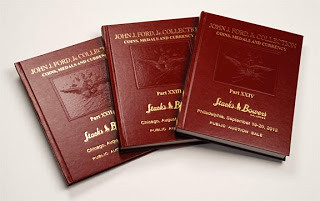
With Prices Realized
These beautiful red hardbound catalogs include the complete auction listings and prices realized for the three most recent sales of the John J. Ford, Jr. Collection. These sales were part of the Stack’s Bowers Galleries official auctions of the 2013 ANA World’s Fair of Money and 2013 Whitman Coin & Collectibles Philadelphia Expo. They continue the longstanding tradition of hardbound Ford Collection auction catalogs and are important references. Whether you have collected the entire set or you are just starting your collection now, these are essential works for any library of numismatic American history.
The JOHN J. FORD, Jr. COLLECTION of COINS, MEDALS AND CURRENCY
August and September 2013
PART XXII
American Paper Currency
Colonial and Continental Currency
Obsolete Currency and Proofs
Confederate and Southern States Currency
United States Fractional Currency
PART XXIII
Tokens of Canada
Medals of Marquis de Lafayette and Benjamin Franklin
Civil War Tokens and Sutler Cards
American Countermarks
Early American, Hard Times, Merchant and Trade Tokens
Indian Trader, Military and Territorial Tokens
Balance Scales
PART XXIV
Western Paper Americana
Private and Territorial Pattern Coins
Medals of Marquis de Lafayette and Benjamin Franklin
American Political Medals
Balance Scales
Quantities are limited – call today to order! 949.253.0916
Stack’s Bowers Galleries President Brian Kendrella writes:
We have them back from our printer and are preparing to send out packages next week.
For more information, or to order, see: Special Hardcover Ford Collection Catalogs For Sale! (stacksbowers.com/Blogs/special-hardcover-ford-collection.html)
NEW BOOK: GUIDE BOOK OF U.S. COINS, PROFESSIONAL EDITION, 5TH EDITION
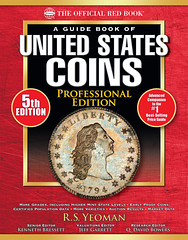 Whitman Publishing has released the fifth edition of its expanded version of the best-selling Guide Book of United States Coins (known within the hobby as the “Red Book”). The 384-page volume, called the Professional Edition, is intended for intermediate and advanced collectors and investors, professional coin dealers, auctioneers, and numismatic researchers. It is available online (including at Whitman.com), at bookstores nationwide, and from hobby dealers and booksellers. The Professional Edition is 45% larger than the regular-edition Red Book, at 8.5 x 11 inches, and is spiralbound for convenient reference. It retails for $29.95.
Whitman Publishing has released the fifth edition of its expanded version of the best-selling Guide Book of United States Coins (known within the hobby as the “Red Book”). The 384-page volume, called the Professional Edition, is intended for intermediate and advanced collectors and investors, professional coin dealers, auctioneers, and numismatic researchers. It is available online (including at Whitman.com), at bookstores nationwide, and from hobby dealers and booksellers. The Professional Edition is 45% larger than the regular-edition Red Book, at 8.5 x 11 inches, and is spiralbound for convenient reference. It retails for $29.95.
Updates in the fifth edition include:
- Current market prices in high circulated grades and multiple Mint State and Proof grades
- Updated auction records
- 43 updated and additional coin photographs, including a chopmarked trade dollar, various Mint State and Proof type coins, and new die varieties
- An illustrated essay on the 1837 “Half Cent Worth of Pure Copper” token
- An essay on the passing of the half cent and large cent from American commerce
- New die varieties, including major 2009 “Formative Years” Lincoln cent doubled-die reverses
- Updated “Recommended Reading” lists
- Whitman Publishing coupons, in the back of the book, worth $38.75
Standard features of the Professional Edition that go beyond the regular-edition Red Book include:
- Detailed coverage of every federal coin type, half cents through double eagles, plus classic commemoratives, Proof and Mint sets, and bullion coins.
- Expanded valuations, including multiple Mint State and Proof levels, plus Full Steps, Full Bands, Full Head, Full Bell Lines, Cameo / Deep Cameo, and other specialized designations.
- Certified-coin population summaries (PCGS and NGC) for every date and mintmark—including the number certified, the average grade, the percent in Mint State, and the finest Proof.
- Recent auction data for coins listed.
- Additional die varieties in every denomination, with close-up photographs for easy identification.
- More than 1,600 high-quality, full-color photographs of Mint State and Proof coins, for every type.
- Detailed research, estimated mintages, and market information on early 1800s–early 1900s Proof coinage, including gold.
- Expert guidance on striking and sharpness characteristics for each type—valuable information when comparing coins for purchase.
- Insight on availability and condition rarity for each type.
- Detailed grading instructions, including for Mint State and Proof coins.
- Informative chart notes that expand on the history, characteristics, and market values of significant coins.
- Enlargements of key focal points and variety diagnostics—many more than in the regular edition.
- A detailed section on the U.S. Mint’s silver, gold, and platinum bullion coins.
- An appendix on “Great Collectors and Collections of the Past.”
The Professional Edition’s editorial team consists of Senior Editor Kenneth Bressett, Research Editor Q. David Bowers, and Valuations Editor Jeff Garrett. Dozens of other hobby leaders contributed their expertise to the book’s production.
“The Professional Edition Red Book is not just for professional coin dealers and investors,” said Whitman publisher Dennis Tucker. “Collectors who have advanced beyond the solid foundation of the regular-edition Red Book will find it to be an invaluable tool for building their collections. As a single-source reference book there’s nothing else like it in the market.”
A Guide Book of United States Coins, Professional Edition, fifth edition
Senior editor Kenneth Bressett; research editor Q. David Bowers; valuations editor Jeff Garrett.
ISBN 079483972-X
384 pages, full color.
8.5 x 11 inches, spiralbound softcover.
Retail $29.95
THE BOOK BAZARRE
NEW BOOK: THE LOS AUSTRIAS COPPERS (1516-1700)
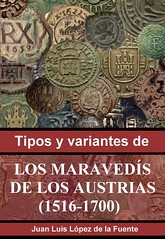 THE LOS AUSTRIAS COPPERS (1516-1700) Types and versions
Author: Juan Luis López de la Fuente
THE LOS AUSTRIAS COPPERS (1516-1700) Types and versions
Author: Juan Luis López de la Fuente
Essential work for collectors Castilian coppers this period. Describes in total 1520 variants of this type of exchange, from Charles I to the demise of the dynasty in 1700 with Charles II.
The book is divided into 6 chapters, corresponding to each of the five kingdoms of the dynasty and another dedicated to coins that were minted in the name of the Catholic Monarchs during the first half of the sixteenth century.
In each chapter there is a classification and a detailed study of the different issues that coin sent over the years, the evidence failed to see the light and different overprints that were performed during the sixteenth century. We describe the legends and discusses the obverse and reverse of each copy that is in the book. It identifies all variants discovered to date emissions, mints, assayers years for a better location.
Offering a total of over 1200 photographs of coins.
334 pages
Over 1200 photographs of black and white coins.
Measures 17 x 24 cm.
PVP: 35 € + Shipping
For more information, or to order, see: THE LOS AUSTRIAS coppers (www.maravedis.net/libros_los_maravedis_de_los_austrias.html)
NEW BOOK: COINS AND JETONS OF FRENCH INDOCHINA
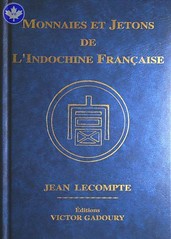 Monnaies et jetons de l'Indochine Française-2014
Monnaies et jetons de l'Indochine Française-2014
Author: Jean Lecompte
Editor: Editions Victor Gadoury
Year: 2014
Language: FRA
Weight: 2.00
A French-English bilingual book of the coins of French Indochina, listing the latest discoveries. Nearly 800 coins listed, over 700 illustrations, 168 pages in color
€49.00
For more information, or to order, see: Monnaies et jetons de l'Indochine Française-2014 (www.gadoury.com/eng/libro-173-monnaies-et-jetons-de-lindochine-franeaise.htm)
BOOK REVIEW: PANIC SCRIP OF 1893, 1907 AND 1914
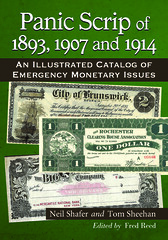 PANIC SCRIP OF 1893, 1907 AND 1914
PANIC SCRIP OF 1893, 1907 AND 1914
An Illustrated Catalog of Emergency Monetary Issues
Neil Shafer and Tom Sheehan
Edited by Fred Reed
416 pages
$75 softcover (7 × 10) 2013
808 photos, appendices, bibliography, index
ISBN 978-0-7864-7577-3 Ebook ISBN 978-1-4766-0570-8
Throughout American history there have been many times of financial crisis and emergency. Many periods of financial stress produced emergency monetary substitutes, some of which are fairly well documented, most notably the "Hard Times", the Civil War, the financial troubles of the 1870s, and the Great Depression. Panic Scrip of 1893, 1907 and 1914 is the much anticipated catalog from Neil Shafer, Tom Sheehan and edited by Fred Reed that attempts to tackle the much less well known and studied crises of 1893, 1907, and 1914 that are equally important to understanding our economic legacy through its fiscal instruments.
Collecting panic scrip from these three periods is a difficult proposition as the issues were never numerous and there are very few issues that can even be remotely considered common. Prior to this book, scant auction records and old economic studies from the times were often all that were available to researchers. This book fills that gap admirably. Panic Scrip includes historical details on the crises, what precipitated them, and the subsequent recovery. It also addresses rarity of almost every issue, both known in numismatic circles, as well as those issues known only through contemporary accounts. Most helpfully, listings where an example is not known are flagged with notations indicating how these issues were uncovered. The book is lavishly illustrated with as many notes as possible.
Part I looks at the Panic of 1893, a period of fiscal crisis that led to the remarkable failure of over 15,000 businesses and more than 500 bank failures. While it took several years to recover from this crash, the emergency scrip from the period is not well known and this is the first attempt at a numismatic compendium of these issues. Some regions were particularly affected by the crisis, in particular areas of the South and the West, and emergency money was circulated to relieve cash shortages and to address back pay.
Part II comprises the various issues of the Panic of 1907 and is also the bulk of the catalog listings. The impact of the Panic of 1907 was felt nationwide and precipitated a period of money shortages impacted the way national bank notes were issued through the Aldrich-Vreeland Act as reflected through the well-known "date back" large size nationals. Less well known in the numismatic community are the hundreds of local and regional emergency notes and clearing house certificates. The variety and scope of these issues, while not at the same level as the later Depression issues, was considerable, and the research gone into this book to catalog these notes is a significant achievement.
Part III is devoted to the financial crisis of 1914, a period that is little studied outside of economic historical circles. While not nearly as well remembered, as Shafer and Sheehan explain, it was from this crisis that gave strength to the brand new Federal Reserve System. These issues are few and far between and represent the transition to a more national banking system under the Federal Reserve. Until I became aware of this book, I was not even aware there were such scrip, so this is much appreciated to see this entry.
The appendices contain a wealth of information found almost nowhere else. There is catalog of related scrip not necessarily tied to these three periods of economic uncertainty, as well as a catalog of contemporaneous satirical issues. In addition, an essay by Loren Gatch addresses how clearing house certificates were used as well as their legality and contains a superb bibliography of many primary sources. Lastly, an article on the fascinating and hitherto undocumented G. B. DeBernardi Labor Exchange scrip by Steven Whitfield provides details on a scrip issue from the late 1890s denominated in "hours" and has until recently been poorly studied.
The index is especially useful for researchers, as it not only lists the issuer, but all participating banks in the case of clearing houses. For instance, the index will have an entry for the "Associated Banks of Lynchburg, Virginia", but also individual entries for its six member banks.
There are only two minor things that I would have loved to have seen: a hardcover edition and perhaps a color section. Many of these notes were very colorful and ornately designed and would have been neat to have a gallery of such examples. That said, this is a minor quibble considering the wealth of information that is contained in the book and one I fully understand given the expense of producing such a book.
Panic Scrip of 1893, 1907 and 1914 joins its predecessor, Standard Catalog of Depression Scrip of the United States, as the authoritative work on the subject matter. As a researcher on Mid-Atlantic monies, I know this certainly inspired me to delve deeper into the various issues from my home region and shine a light on these otherwise overlooked notes. I would encourage anyone with a passing interest in these pieces of our numismatic heritage to add this book to their library.
I collected clearing house certificates for many years and was pleased to be able to contribute to the book. I specialized in 1907 Pittsburgh notes and thought I had the market cornered; yet that section of the catalog is brimming with issues that I never had and have never seen. These are all generally rare today, making the book the only place many of these are recorded in the literature.
As a bibliophile I will echo Eric's disappointment at not having a hardcover edition - all the better to withstand the years of use this volume will see in my library. I am also disappointed that the images are only in black and white. However, this is more a reflection on the raised expectations of today's numismatists in a world where the cost of color printing has dropped considerably and full color auction catalogs are commonplace.
My only other disappointment is not fault of the book's authors. As a catalog, its purpose is to catalog the known specimens; more information about the history behind individual issues is beyond the scope of the book. As a collector I was hoping to learn more about the Labor Exchange notes in the Appendix, and Steve Whitfield's essay only scratched the surface. But his catalog is a very useful starting point, and as we have seen with Eric, the book is already becoming a jumping-off point for the next generation of researchers into this important and fascinating area of U.S. financial and numismatic history. Congratulations to the authors and Editor Fred Reed for creating an indispensable volume for American numismatic libraries. -Editor
To read the earlier E-Sylum article, see: NEW BOOK: PANIC SCRIP OF 1893, 1907 AND 1914 (www.coinbooks.org/esylum_v16n43a05.html)
BOOK REVIEW: HEATH’S COUNTERFEIT DETECTOR, 11TH EDITION
 In the circulating stacks for numismatics at the University of Texas (Austin) Library, I found Heath’s Infallible Counterfeit Detector at Sight by Authority from the United States Treasury Department (Pocket Edition) published by the author as Laban Heath & Co., No 30 Hanover Street, Boston. This is the eleventh edition of 1873. It is octavo (6-7/8 by 4-3/8 or 11 x 17 cm ) of 40 pages plus 22 pages with 11 uniface pages of illustrations.
In the circulating stacks for numismatics at the University of Texas (Austin) Library, I found Heath’s Infallible Counterfeit Detector at Sight by Authority from the United States Treasury Department (Pocket Edition) published by the author as Laban Heath & Co., No 30 Hanover Street, Boston. This is the eleventh edition of 1873. It is octavo (6-7/8 by 4-3/8 or 11 x 17 cm ) of 40 pages plus 22 pages with 11 uniface pages of illustrations.
“Having had unlimited experience in the detection of counterfeit and altered bank-notes, I felt the necessity of placing this knowledge within the reach of all; consequently, in June 1864, I published the first edition of “Heath’s Counterfeit Detector,” which met with such favor from the public that it reached the enormous sale of twenty-five thousand copies, and would have far exceeded this number had not the whole currency of the country been changed to what is commonly known as greenbacks, and national bank-bills.” – Introduction.
Laban Heath obtained permissions and material support from the U.S. Treasury as well as from the private firms: National Bank Note Co. of New York and Boston, the American Bank Note Company of New York, and the Continental Bank Note Company of New York.
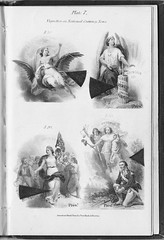
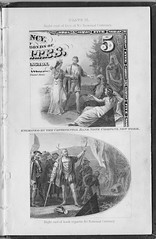
“The success of counterfeiters in circulating their spurious issues is not at all due to any excellence of work that would deceive a practiced eye, but to the general ignorance of the public as to what constitutes good and poor engraving.”
Heath’s of course was but one of several serving the same purpose. Providing an overview for The Asylum (Volume II Number 1), Kirby W. Brown wrote: “Common to all of these publications is division of the text into “rules” for detecting counterfeits. For example, Eastman's 1859 work is divided into 10 principle rules: Geometrical lathe work; parallel ruling (ruling engine); medallion ruling or engraving; perspective (appearance); vignettes; printing; lettering; ink; engraver's Imprint; and signatures.” Indeed, the Introduction to Heath’s enumerates five: Geometrical Lathe Work, Ruling Engine Work, Vignettes, Solid Print, and Minor Rules. Each of them is the title of a subhead.
Heath also sold a microscope for inspecting notes. According to the description in this book, the device could be reconfigured as a magnifier, microscope, or telescope. Made in Paris, it sold for five dollars.
The little book is a delightful read. I have been through it twice; and both times coming to the last word was like having to leave a party.
To view the NBS Wiki bibliography page on Heath's, see:
Heath’s Infallible Counterfeit Detector
(wiki.coinbooks.org/index.php/HEATH%E2%80%
99S_INFALLIBLE_COUNTERFEIT_DETECTOR_AT_SIGHT)
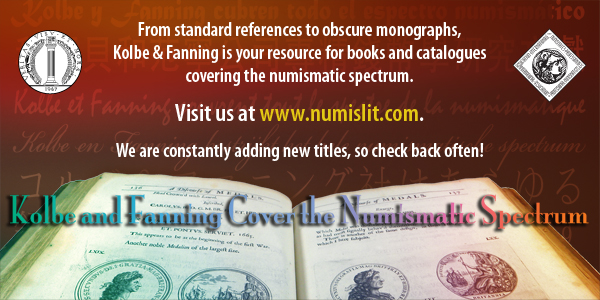
READERS REMEMBER GEORGE J. FULD
Mike Marotta writes:
A few days after I received the third edition of A Guide Book of Civil War Tokens by Q. David Bowers, the passing of George Fuld was announced. Fuld’s “Reminiscence” follows the Forward by Fred Reed and leads the Introduction by QDB. George Fuld pursued much more than CWTs.
In that remembrance, Fuld mentions that his first book on Store Cards, published by Krause, ran 350 pages and was 8-1/2 x 11 inches, whereas the Quarterman reprint was 6 x 9. It was not an idle detail. Fuld wrote “Numismatic book collecting in the 50s.” for The Asylum (vol 11, no. 3 (Summer 1993, p. 3-6). In all, he has 95 index citations in the ANS Donum catalog, touring the latitudes of exonumia from Washington Peace Medals to Colgate-Palmolive Coupon Checks. The ANA library shelves two videos. The Manley Medal of Washington is a DVD recording of Dr. Fuld’s 2008 lecture at the ANA. They also hold a 1986 VHS recording of Fuld being interviewed by David Lisot.
George J. Fuld graduated from MIT with a bachelor’s in chemical engineering in 1953. In 1957, he completed a doctorate of science. While an MIT undergraduate, he chaired a committee to organize the annual Dormitory Acquaintance Dance, held October 5, 1951. They brought in and took back to their homes 300 (“selected”) girls from area colleges Wellesley, Lasell Junior College, Bradford College, Boston University, Jackson College, and Simmons College. Admission for men was $1.25. (The Tech, September 28, 1951 online at http://tech.mit.edu/V71/PDF/V71-N31.pdf.) Later that school year, at an April carnival, he bid on and won the services of a dean to be his chauffeur at the spring formal. (The Tech, April 15, 1952, online at http://tech.mit.edu/V72/PDF/V72-N17.pdf.)
The ANS provides a terse biography ( http://numismatics.org/Archives/Gjfuldbio) citing his work as a consultant and researcher in industrial chemistry. In fact, Fuld published several professional papers on fermentation processes, among them was “Continuous Hydroxylation of Progesterone by Aspergillus Ochrachaeus” which he co-authored with Richard J. Mateles. He also chaired a committee to review papers for an American Chemical Society convention in New York City in 1959: Applications of Experimental Design and Statistics . (Fermentation Subdivision). Submission was by invitation. (See http://pubs.acs.org/doi/pdf/10.1021/cen-v037n042.p084.)
Such sad news. I was just looking and his Getz dollar book the other day - I guess it's his last work. So sad, what a great loss.
Saul Teichman writes:
George was a great guy. I had many discussions with him on pattern coinage with George Washington on the obverse and on 1827 half eagle pedigrees. He will be missed.
David T. Alexander writes:
The loss of George J. Fuld is a significant one for all of numismatics. The work which he and his late father Melvin did with Civil War Tokens was heroic, and opened up a long-fallow field to generations of modern collectors. Bringing out an updated version of William Spohn Baker's classic work on Washington medals and tokens was another significant effort in which he worked closely with the late Russell Rulau.
George worked with me on the award-winning 1983 San Diego ANA convention sale for Kagin's, then located in Des Moines, Iowa, and San Francisco. Later, when we were cataloging the John J. Ford Collection at the real Stack's, George and Doris were on hand, spending one epic night on the show room sofa during the great New York City blackout. No elevators, but they persevered.
Two weeks ago we lost a pillar of the Westchester County (NY) Coin Club, John P. Jensen. Like George, John did the work of many people to keep this important suburban club up and running. Both of these men will be impossible to really replace.
Dick Johnson writes:
George Fuld was a good friend, a fellow founder of the Rittenhouse Society, a knowledgeable numismatist, researcher and writer. I would like to site an example of his extensive knowledge.
The year was 1953. I was in the military stationed in Washington D.C. He lived with his parents in Baltimore, Maryland. We agreed to meet for a day to look at his token collection. I drove to Baltimore; his home was right near Pimlico race track. I didn't wear my Air Force uniform, I remember buying new civilian clothes for the occasion. I spent the day there and at the end of the day his father Melvin came home. It was the only time I met his father, who also was active in collecting and co-authored with George on their many books.
George brought out a part of his collection. One token he showed me was badly tarnished. He picked up a pencil and applied the eraser vigorously rubbing the surface of the token. It removed the tarnish and brought up the golden color of the bronze underneath. I was incensed he did this to his specimen, but didn’t say anything at the time.
Little did I know that 40 years later I learned about that soft eraser -- it is mildly abrasive. It doesn't harm the surface of a token as it doesn't harm a sheet of paper. We had hired an Australian diesinker at Medallic Art Company, he taught me about Cratex. He used a tool made of Cratex often used in die engraving. Cratex is the same material as the eraser part of a wooden pencil.
I remembered George Fuld using it on his token. Cratex did the job. George undoubtedly learned this trick-of-the-trade from an old-time numismatist. It was part of his extensive knowledge of numismatics.
LEARN THE TERM: CRATEX
Other than a vise (irreverently called a engraver’s ball), numerous engravers, burins and chisels, a Cratex stick is a die engraver’s most useful tool. It is used for smoothing and polishing the steel face of a die. It is made of rubberized composition embedded with abrasives.
Cratex comes in five forms: pointed, cone shaped, and wheels, all mounted on spindles for use with a hand-held Dramel. It also comes in blocks, and sticks. A pointed Cratex could add dimples as polka dots in a garment. A wheel can cut a fine line in a steel die from its abrasives.
It comes in four degrees of coarse abrasive, each with a different color. Fine is reddish brown (like a pencil eraser), extra fine is gray green, medium is dark brown, coarse is green. A block or round stick of Cratex is a tool always on a diesinker's workbench.
If you learn this new term, it is in memory of George Fuld, who exposed me to the use of Cratex 60 years ago this year. George had knowledge of it that early.
To read the earlier E-Sylum article, see: GEORGE J. FULD 1932 - 2013 (www.coinbooks.org/esylum_v16n43a03.html)
NOTES FROM E-SYLUM READERS: OCTOBER 27, 2013
On the 1980s Salvadoran Gold Coin Hoard
Responding to Roberto Jovel's question about the 1980s Salvadoran Gold Coin Hoard, an E-Sylum reader writes:
The only reference I found was to a June 1989 Heritage auction. The catalog provides the background of 460 gold 1909-S $20 coins apparently from the other nations’ central bank. A PDF of the page from the catalog with the story is attached.
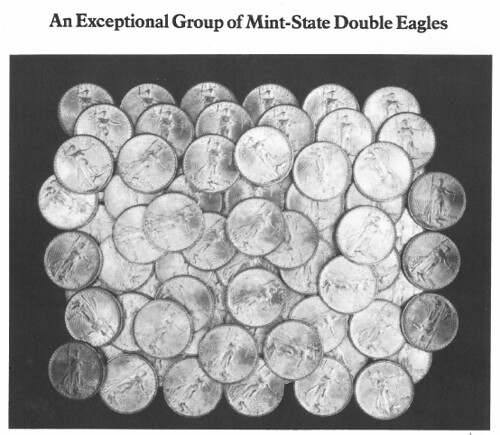
To read the earlier E-Sylum article, see: NOTES FROM E-SYLUM READERS: OCTOBER 20, 2013 : Query: Information on 1980s Salvadoran Gold Coin Hoard Sought (www.coinbooks.org/esylum_v16n43a12.html)
Fitzwilliam Museum Medal: Is There a Monaco Connection?
Martin Purdy writes:
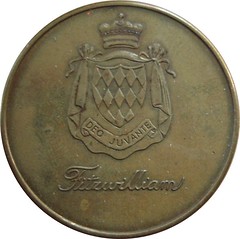 I recently picked up the attached medal from or relating to the Fitzwilliam Museum in Cambridge (brass, 38mm, presumably 1970s-1980s) and noticed something familiar about those arms: the lozenges and the motto "DEO JUVANTE" are also found on the coins of Monaco. What's the connection? I have no idea as yet, but would love to know! Can any readers help?
I recently picked up the attached medal from or relating to the Fitzwilliam Museum in Cambridge (brass, 38mm, presumably 1970s-1980s) and noticed something familiar about those arms: the lozenges and the motto "DEO JUVANTE" are also found on the coins of Monaco. What's the connection? I have no idea as yet, but would love to know! Can any readers help?
To read the earlier E-Sylum article, see: FEATURED WEB PAGE: THE FITZWILLIAM MUSEUM COIN CABINET (www.coinbooks.org/esylum_v16n43a29.html)
On One-Coin Coin Books
Ginger Rapsus writes:
I want you to know that I also look forward to The E-Sylum. Each issue contains so much info & feedback. It takes time & effort to do this. Thank you. I also wish to mention that I wrote an article on one-coin books. "Books tell stories of special coins," which appeared in Numismatic News last February
To read the earlier E-Sylum article, see: JOEL OROSZ ON ONE-COIN COIN BOOKS (www.coinbooks.org/esylum_v16n43a19.html)
On Finding Typos
Steve D'Ippolito writes:
It's a truism in exhibiting at American Numismatic Association conventions that the glaring mistake will become apparent within minutes of Gene Hynds and/or Mark Lighterman sealing the cases. In fact, when I am ready to have them close the cases, I actually tell them it's time to help me find the typo.
To read the earlier E-Sylum article, see: NOTES FROM E-SYLUM READERS: OCTOBER 20, 2013 : The New $110 Bill (www.coinbooks.org/esylum_v16n43a12.html)
SOME IMAGES FROM PABITRA SAHA: OCTOBER 27, 2013
Lithuania 50 Litu 2013
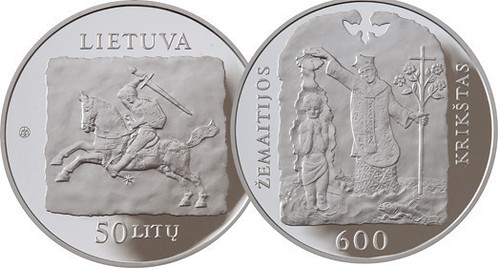
This one caught my eye because of the contrast between the rough background of the central images and the smooth field surrounding them. I think it works very well. The subject is the "600th anniversary of the christening of Samogitia"
St Eligius, Patron Saint of Numismatics
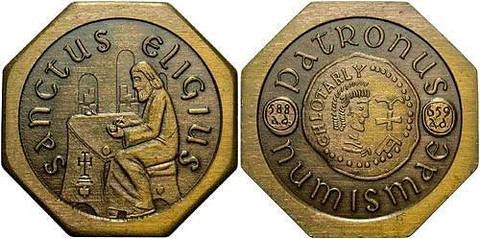
This one isn't a coin, but a token or medal of some kind. I don't think I've seen this before. Can anyone help?
Pabitra Saha adds:
I just got this from a friend. I had no idea that there existed a patron saint for numismatics. I would be very happy if E-Sylum readers could provide information on any aspect of this medal or the Saint. I am trying to organise the minting of a good medallion on this myself.
Wikipedia describes Saint Eligius as "the patron saint of goldsmiths, other metalworkers, and coin collectors. He is also the patron saint of the Royal Electrical and Mechanical Engineers (REME), a corps of the British Army, but he is best known for being the patron saint of horses and those who work with them. "
To read more on Wikipedia, see: Saint Eligius (en.wikipedia.org/wiki/Saint_Eligius)
TURN YOUR SMARTPHONE INTO A COIN MICROSCOPE
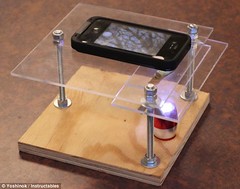 Smartphone cameras are getting more advanced all the time, but now a DIY fan has revealed how crafty iPhone owners can make a microscope for their handset for under $10.
Smartphone cameras are getting more advanced all the time, but now a DIY fan has revealed how crafty iPhone owners can make a microscope for their handset for under $10.
Using a block of wood, some plexiglass and the lens from a laser pointer, a video shows how users can make a microscope with 175x magnification for an iPhone. Once the project is completed, the smartphone can be used to take photos of things as small as the nuclei of plant cells as well as for macro photography projects.
According to crafting website Instructables, the DIY microscope can be made in just 20 minutes and costs under $10, excluding the price of the smartphone.
The lens for the microscope comes from a cheap laser pointer and the website explains how it can be freed from its casing and placed in the correct way against the camera lens of the iPhone using a hairpin.
It is this lens that creates the larger field of view and can itself be used to take macro shots.
The assembly of the rig requires basic DIY skills, including the use of a drill, as well as a few nuts and bolts. A hole must be drilled in the camera stage just large enough for the lens to sit in and it is vital it is as close as possible to the camera.
To read the complete article, see: The DIY smartphone MICROSCOPE: Turn your mobile into a piece of expert kit using a block of wood and a laser pointer (www.dailymail.co.uk/sciencetech/article-2470246/DIY-smartphone-MICROSCOPE-Turn-mobile-expert-kit.html)
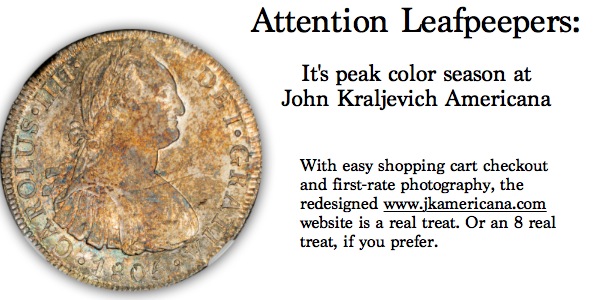
SELECTIONS FROM THE NOVEMBER 16, 2013 CHARLES DAVIS SALE

Lot 351: The Decorah Numismatic Journal
E. W. HOLWAY: The Decorah Numismatic Journal, 1875,
Cooley & Holway, Decorah Iowa, 4 issues, all published, 40
(4) pages, 5½x8", beige wrappers. Fine. (100.00)
Perhaps the rarest of American numismatic periodicals, one has to question
why it existed in the first place, other than perhaps to eat up otherwise idle
time on a press. In the 1st issue it predicted its demise which was announced
in the 4th issue despite having received a two line plug in the American Journal
of Numismatics. Its content dealt primarily with the coins and medals of
Germany, not a surprise as Decorah was the home to Luther College.
Lot 352: Annotated Johnson on Bolen Cards
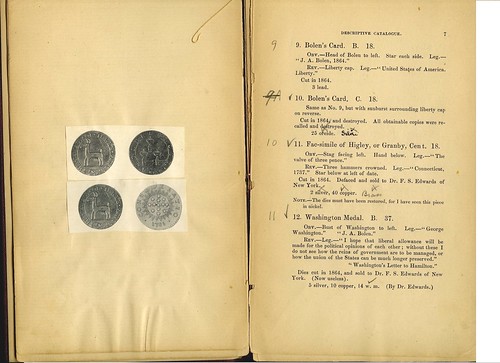
EDWIN L. JOHNSON: J. A. Bolen’s Medals, Cards, and Fac-Similes. An Accurate and Comprehensive Descriptive Catalogue of Bolen’s Works, With Number Struck in Each Metal, Springfield, Mass., 1882, 14, (4) pages, interleaved with blank sheets on which halftone photographs have been pasted, heavily annotated throughout in pencil, original russet cloth stamped in blind and gilt, pages mostly loose in the case (400.00)
Davis 542. Copy No. 32 with that numeral stamped in blue ink under the copyright notice. Extremely scarce, for although 150 copies may have been prepared, few seem to have survived. As published, the list enumerates and describes 43 tokens. In the present example, No. 44 has been added in a neat pen (“dies cut Oct. 1893 - 250 copper, 465 aluminum”). Each page is then annotated in pencil with the number struck in each metal receiving a check mark. In some cases, an additional metal (brass, w.m.) has been noted. The illustrations were pinched from the serial publication “Live American Numismatic Items” which ran in The Numismatist 1911-1912.
Lot 619: Dr. Sheldon’s Signed Copy of Würtzbach
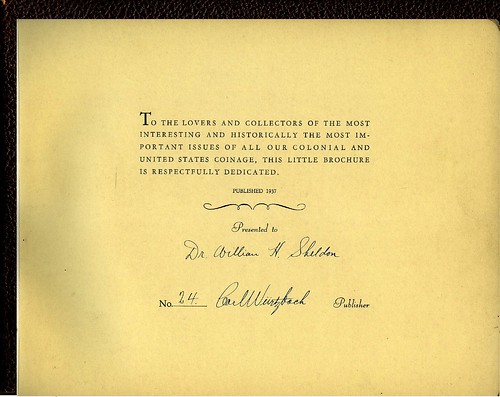
CARL WÜRTZBACH: (Complete Set of Massachusetts Colonial Silver Money), Lee, Massachusetts, 1937, portrait of the author, 8 printed leaves, errata slip, four double page photographic plates depicting obverses and reverses of 83 coins, oblong quarto, 21½x28½ cm, maroon grained composition folder. Little if at all used, but the front cover is detached, an unfortunate but not uncommon condition. (600.00)
Davis 1199. Copy No. 24 signed by Wurtzbach and presented to Dr. William H. Sheldon. In the November 1947 issue of The Numismatist, Sheldon wrote Wurtzbach’s obituary referring to the work as a “brochure, the standard reference on the subject, illustrated from his own collection, later purchased by T. J. Clarke and one of the finest in the field.” He further called Wurtzbach “with Mr. Hines, Mr. Newcomb, and Mr. Clapp, the big 4 of the big cents. A beloved friend ...a shrewd, straight, and courageous trader.”
In the almost simultaneously dated preface to Early American Cents, he acknowledged “the heaviest indebtedness to the Chapman brothers, Carl Wurtzbach, J. Macallister and George Clapp. Proud of his accomplishment, Wurtzbach prepared this photographic record, probably in an edition of fewer than 50 (not sequentially numbered) copies, for presentation to his friends, although it would appear that many copies were distributed after his death and are not signed. The collection contained coins with awesome pedigrees: Brand, Bushnell, Clay, Hall, Finotti, McCoy, Mickley, Parmelee, and Stickney among others. The errata slip, which corrects the failure to describe variety No. 52 in the main text, is not present in all copies seen.
To view the catalog online, see: www.charlesdavisnumismatics.com/numis_images/SaleNov16.pdf
BRYAN DOLLAR INSCRIPTION: SOUGHT AND FOUND
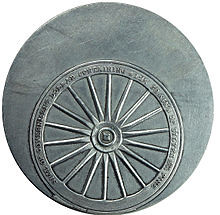 Jim Duncan of New Zealand writes:
Jim Duncan of New Zealand writes:
I have an illustration of a "Bryan Dollar" - it looks like a cartwheel set on a larger flan, and I understand the message. But I can't read the legend on the inner circle. Can one of your erudite correspondents throw some light on same?
The medals were made during the presidential campaigns of William Jennings Bryan and referred to the fight over free silver and different proposed standards. Here are a couple images for similar pieces found in auction sales. Readers can click on the image to see a larger version on our Flickr archive, or go to the auction house site for the best view. -Editor
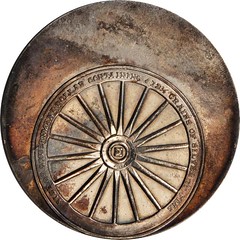
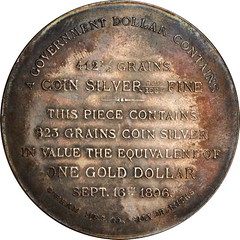
1896 Bryan Dollar. HK-780, Schornstein-6, Zerbe-5.;
Stack's Bowers March 2012 Sale, Lot 328
To view the complete lot description, see: stacksbowers.com/auctions/AuctionLot.aspx?LotID=285252
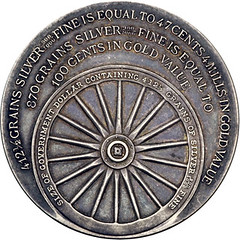
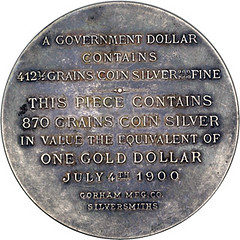
1900. Bryan Dollar, HK-782; Goldberg Sale 13 Lot 2330
To view the complete lot description, see: images.goldbergauctions.com/php/lot_auc.php?site=1&sale=13&lot=2330&lang=1
COL. GREEN AND THE CHARLES W. MORGAN
Colonel Green rescued the last full masted whaling ship, the Charles W. Morgan, had it totally restored, and berthed it in a specially built enclosed pier on his Round Hill Estate facing Buzzard’s Bay at South Dartmouth, Massachusetts. A small whaling village was recreated alongside it.
The 105 foot long ship built in 1841, had at one time been owned by the Colonel’s grandfather, “Blackhawk” Robinson, Hetty Green’s father. The Colonel opened the ship to the public free of charge, and it drew about 100,000 visitors annually from1926 until he died in 1936. The ship eventually was put on display at Mystic, Connecticut, after his death, where it remains to this day. By the time the boat was towed to Mystic in December 1941, it was once again in serious need of repair.
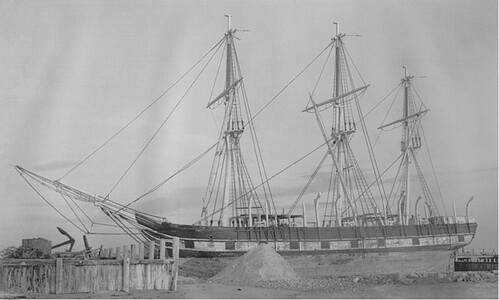
The Charles W. Morgan in its berth at Round Hill, South Dartmouth, Massachusetts.
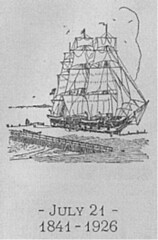
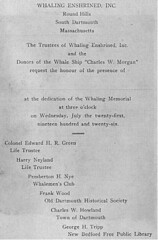
Brochure from the dedication of the opening of the
Charles W. Morgan on July 21, 1926
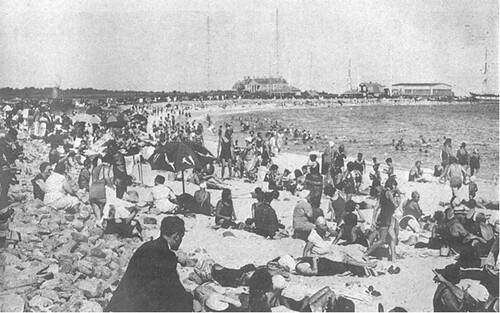
ABOVE: A weekend crowd enjoys the beach at Col. Green’s Round Hill Estate facing Buzzard’s Bay. The Charles W. Morgan is at the far right next to the airplane hangar. Look for the tall mast and you will see the ship below it. The Colonel generously opened the beach to the public on summer weekends and hired a crew to clean up their litter during the week. His Round Hill Estate home is at the center on the horizon. The towers and other buildings were facilities built by him to facilitate research he sponsored through MIT on radio, radar and radioactivity, as well as a radio station he owned on the site. His airport was state of the art for the times, reportedly the best in New England.
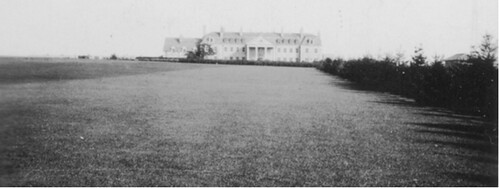
ABOVE: Front lawn of the Colonel’s Round Hill Estate on September 23, 1931, a photo taken by my uncle, John Klemann Jr., son of John A. Klemann of the Nassau Stamp Company in New York. The latter was in negotiation with the Colonel on the purchase of coins and stamps. The Colonel would set up huge speakers on the lawn, than invite everyone from New Bedford and surrounding communities to bring their families out, park their cars and spread out blankets on the ground to listen to big events such as sportscasts that were being broadcast from his on-site radio station.
See and read more at:
Bedell, Barbara Fortin, 2003, Colonel Edward Howland Robinson Green and the world he created at Round Hill: Privately printed, 150 pages. (terrific collection of photos).
Huntoon, Peter, and Barbara Bedell, Jan-Feb 2009, Colonel Edward H. R. Green, collector extraordinaire and the story of the number 1 Series of 1929 sheets: Paper Money, v. 48, p. 34-56.
Reader Ken Berger asks a great question: "I wonder what coin they found under the original mast when they removed it to replace it?"
Here's more on the numismatic connection, and how the young Eric P. Newman met Col. Green and bested better-heeled competitors to purchase the Green collection. Be sure to read the complete article online. -Editor
The story began when Newman was a student at Massachusetts Institute of Technology in the late 1920s, where Eric and other students were following Rear Admiral Richard E. Byrd's first Antarctic expedition (1928-1930).
Eric put aside the newspaper headlines, and opted to use a crystal shortwave radio set that he and other students built to listen to the historic event... But there was so much static in the transmissions, that it required frequent resending of messages, because only a portion would be heard at any one time.
To help relay the transmissions better, Colonel Green offered the services of his private radio station in Roundtree, Massachusetts, to follow Byrd's historic Antarctic expedition. [Peter Huntoon points out that this should be "at his Round Hill Estate in South Dartmouth, Massachusetts" - Editor]
That offer, and the interest of the MIT students came in very handy during that first expedition, when a member of Byrd’s crew was diagnosed with appendicitis and immediately required surgery.
Newman and other students volunteered to contact doctors all over the world, especially Norway and Sweden, via shortwave radio, to see how to do the surgery at temperatures of 40 degrees below zero. They found a solution, transferred the information to Byrd's team, and the patient lived.
Colonel Green came to MIT to thank these young volunteers, who helped transmit the information to Admiral Byrd, and Eric Newman was in absolute awe for this personal visit.
By the time Colonel Green died in 1936, Newman had graduated from MIT and was practicing law... and he knew that Colonel Green had a gigantic numismatic collection.
Newman decided he wanted a $5 Demand Note of 1861 for St. Louis, that Green had in his collection, but the Chase National Bank was executor of Green’s estate... so Eric wrote a letter to the bank and asked to buy the note.
To read the complete Eric P. Newman story, see: THE ERIC P. NEWMAN STORY (urc.universityrarecoins.com/urccontent/wbd/M102_EricPNewman-Story.pdf)
To read the earlier E-Sylum article, see: STEPPING THE MAST OF THE WHALING SHIP CHARLES W. MORGAN (www.coinbooks.org/esylum_v16n43a25.html)
THE BOOK BAZARRE
ERIC NEWMAN'S PROOF 1818 QUARTER
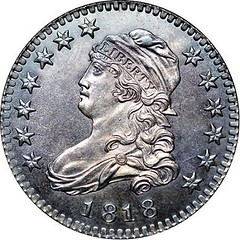 This is the fourth in a series on the Eric Newman US Coins Collection, one of the most famous US coin collections ever formed. Here in part 4, the focus is on Newman’s certified “Proof-67” 1818 Capped Bust Quarter. Heritage will auction this coin and many other coins from the Eric Newman Collection in New York on Nov. 15th and 16th.
This is the fourth in a series on the Eric Newman US Coins Collection, one of the most famous US coin collections ever formed. Here in part 4, the focus is on Newman’s certified “Proof-67” 1818 Capped Bust Quarter. Heritage will auction this coin and many other coins from the Eric Newman Collection in New York on Nov. 15th and 16th.
This 1818 quarter is the only pre-1820 silver coin that I have ever seen that I regard as a true Proof, and I have been persistently examining 19th century Proof coins at major events for more than twenty years.
I have never seen a pre-1820 gold coin that I regard as a Proof, though I have seen two that are Specimen Strikings. The two or three 1817 large cents and one 1819/8 large cent that are certified as Proofs are certainly controversial. I will discuss these at another time.
Richard Burdick remarks that, in all the decades that he has been carefully studying large cents, he does “not remember ever seeing a pre-1820 large cent that I called a Proof. The 1819/8 cent in the Pittman Collection is not a Proof.” The Pittman coin is the 1819/8 large cent that is certified as being a “Proof.” Burdick has seen most of the surviving large cents that are Proofs or have been represented as Proofs. Indeed, Richard assembled one of the all-time greatest collections of Proof large cents, which he sold to Ted Naftzger.
Also, I have never come across a serious report of a pre-1820 dime or half dime being a Proof. None of the Proof silver dollars dated 1801, 1802, 1803 or 1804 could have been minted prior to 1834.
This 1818 quarter is not an obvious Proof. It fulfills minimum criteria to be a Proof. It is not the most convincing pre-1830 Proof silver coin that I have ever seen, though it has more powerful Proof characteristics than some other true, pre-1840 Proofs.
To read the complete article, see: The Fabulous Eric Newman US Coins Collection, Part 4: Proof 1818 Quarter (www.coinweek.com/featured-news/fabulous-eric-newman-us-coins-collection-part-4-proof-1818-quarter/)
U.S. COIN COLLECTOR WINNER F. DELP
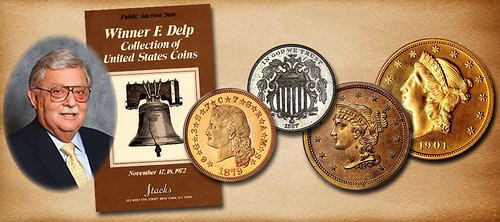
One recent weekend I was reviewing a group of Stack’s public auction catalogs from the early 1970s. I came across the name, Winner F. Delp -- Stack's conducted the sale of his collection in November 1972. Winner was a personal friend of the Stack family and I had the privilege of helping him build his noteworthy collection. He started collecting just before in went into service in World War II in 1942 and returned to numismatics upon his return home in 1947.
Mr. Delp loved well struck specimens, lovely iridescent toning and very attractive examples. How was he able to acquire so many choice and gem examples? It is a matter of timing and history. Many early collections were started in the 1920s and suddenly stopped being developed during the four years of World War II. Major collectors were drafted into service and were busy fighting a war; they had no time for collecting. However, there were old timers from the 1920s through the early 1940s who unfortunately passed away or lost interest. For this reason, collectors of the period had an unusual selection to choose from, and they of course collected the best they could find. The dealers of the period had huge inventories acquired during the 1920s through the end of the War, increasing the choices for collectors.
Some of the great pedigree names we know today came from the inventories assembled and accumulated during this period. For a dealer to have a dozen or even a roll or two of a given date on hand gave the collector a wide choice. So in collections formed from the 1940s to the mid 1970s one could find outstanding pieces, sometimes in abundance.
As I read the Delp catalog, which was a great collection for the 1970s and an outstanding collection in today’s terms, the list of prior owners was amazing. To give you an idea of the pedigrees found in this one collection the pedigrees included: the Randall Hoard, T.K. Harvin, John J. Pittman, Sam Wolfson, Grant Pierce, Charles Jay, Massachusetts Historical Society, Fairbanks, Woodin, F.C.C. Boyd, King Farouk, R.L. Miles , Jr., Maurice Bauman, Calvin Emmons, Alto, Gaston DiBello, Jerome Kern, George Walton, James Dines, and many more. These names became legendary after their collections were sold, and are repeated with pride in the pedigrees listed in many outstanding collections being offered today.
That's is how the value of pedigree grows. Old name collections of yesteryear, known for the quality of the items, become well known as they are noted in the catalogs later offering the pieces for sale. As collections were sold and the coins moved to later collections, the pedigrees are expanded to reflect the collectors who have appreciated the pieces in the past.
If you are a student and understand the value of pedigree, you appreciate the ownership of a "known coin of the past" and cherish it because it did survive. That was the approach of Winner F. Delp -- to gather together specimens that were cherished by others before him and add them to his. He did what every noteworthy collector did: he found a coin, examined it, studied it, developed a liking for it, and with pride added it to his collection.
To read the complete article, see: Remember When: Winner F. Delp (stacksbowers.com/Blogs/remember-when-winner-f-delp.html)
JAY PARRINO'S THE MINT OFFERS VINTAGE PHOTOGRAPHS
For those of us who remember Jay Parrino's numismatic prominence more than a decade ago and wonder what he's doing right now : I was surfing eBay this week and to my surprise I encountered a vintage photograph being offered by Jay Parrino.
I delved into the listing further and discovered Jay is in Overland Park, KS and sells on eBay under JP-The Mint with a feedback of 93,950, one of the highest feedbacks I've seen. His firm name is still Jay Parrino's The Mint and he claims to be "eBay's oldest and largest dealer of Certified Vintage Photographs and Certified Archive Photos".
So evidently Parrino still seeks prominence in the field in which he specializes. It is still a mystery to most why he so abruptly left numismatics, tried his hand prominently in rare stamps, rare comics, rare movie posters and now...
On another note, we all wondered how anyone could get out financially from the prices Parrino used to charge and get for extraordinary top quality rare coins. Now we look back nostalgically at those prices. Who wudda guessed?
To read the complete article, see: www.jp-themint.com

WHY PAPER STILL BEATS SCREENS
One of the most provocative viral YouTube videos in the past two years begins mundanely enough: a one-year-old girl plays with an iPad, sweeping her fingers across its touch screen and shuffling groups of icons. In following scenes, she appears to pinch, swipe and prod the pages of paper magazines as though they, too, are screens. Melodramatically, the video replays these gestures in close-up.
For the girl's father, the video- A Magazine is an iPad That Does Not Work -is evidence of a generational transition. In an accompanying description. he writes, "Magazines are now useless and impossible to understand, for digital natives"-that is, for people who have been interacting with digital technologies from a very early age, surrounded not only by paper books and maga1ines but also by smartphones, Kindles and iPads.
Whether or not his daughter truly expected the magazines to behave like an iPad, the video brings into focus a question that is relevant to far more than the youngest among us: How exactly does the technology we use to read change the way we read?
Since at least the 1980s researchers in psychology, computer engineering. and library and information science have published more than 100 studies exploring differences in how people read on paper and on screens. Before 1992 most experiments concluded that people read stories and articles on screens more slowly and remember less about them. As the resolution of screens on all kinds of devices sharpened, however, a more mixed set of findings began to emerge. Recent surveys suggest that although most people still prefer paper-especially when they need to concentrate for a long time-attitudes are changing as tablets and e-reading technology improve and as reading digital texts for facts and fun becomes more common. In the U.S., e-books currently make up more than 20 percent of all books sold to the general public.
Despite all the increasingly user-friendly and popular technology, most studies published since the early 1990s confirm earlier conclusions: paper still has advantages over screens as a reading medium. Together laboratory experiments, polls and consumer reports indicate that digital devices prevent people from efficiently navigating long texts, which may subtly inhibit reading comprehension.
Compared with paper, screens may also drain more of our mental resources while we are reading and make it a little harder to remember what we read when we are done. Whether they realize it or not, people often approach computers and tablets with a state of mind less conducive to learning than the one they bring to paper.
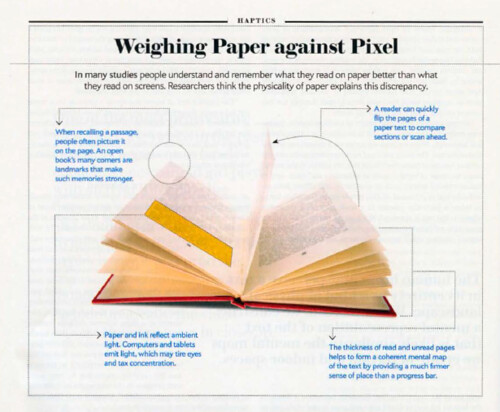
To read the complete article (subscription required), see: The Reading Brain in the Digital Age: Why Paper Still Beats Screens (www.scientificamerican.com/article.cfm?id=the-reading-brain-in-the-digital-age-why-paper-still-beats-screens)
INSCRIPTIONS ON THE 1604 HENRY IIII MEDAL
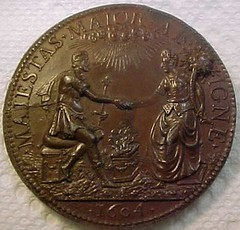 The legend "majestas major ab igne" means "majesty greater from the fire" rather than "majesty greater than the fire" (which would be "major quam ignis" or "major igne").
The legend "majestas major ab igne" means "majesty greater from the fire" rather than "majesty greater than the fire" (which would be "major quam ignis" or "major igne").
The meaning is rather obscure. One interpretation is "the fire of their love increases the majesty of the throne".
The king and queen joining hands, sunshine dispelling clouds above, the fire rising on the conjugal altar suggest the end of some domestic quarrel, which is Henri-Philippe de Limiers' interpretation: http://books.google.com/books?id=Yfu-mXJdiUMC&pg=RA2-PA31 although his precise story (Henri IV retrieving a promise of marriage he had made in writing to a mistress) does not quite seem worthy of a medal.
I doubt that the cornucopia alludes to Marie's dowry. It would have been rather tacky, and the sum of 600,000 gold écus, while large, only represented about 5% of the French crown's annual revenues. Also, she was the daughter of grand-duke Francesco I, and only distantly related to the Medici bankers, coming from another line of Medici who became dukes (later grand-dukes) of Florence after the extinction of the Medici banker line in 1531.
To read the earlier E-Sylum article, see: MORE ON THE 1604 HENRY IIII MEDAL (www.coinbooks.org/esylum_v16n43a13.html)
GORNY & MOSCH OCTOBER 2013 AUCTION SALE REVIEW
14th-18th October 2013
Gorny & Mosch
Auction sales 215-217
Roman gold medallion at Gorny & Mosch yields 644,000 euros!
On 14th October 2013, on the occasion of auction sale 215, Gorny & Mosch sold a unique medallion of Constantine the Great that had been issued to celebrate his jubilee. After a fierce bidding fight, the piece changed hands for 644,000* euros.
26.77 g is the weight of the probably most expensive coin sold at Munich ever. This coin is a very particular one, a special emission issued on the occasion of the reigning anniversary of Constantine the Great. On its obverse it shows the bust of the emperor with a diadem. On the reverse, two winged Victories hold a wreath with VOT / XXX written within.
The reverse depiction indicates that this sextuple solidus was a coin specifically produced to be distributed to soldiers and officials on a special occasion. After all, on the occasion of accession day, birthdays, reigning anniversaries and other official celebrations, they were given an extra donation as an addition to their pay. The specimen shown here is likely to have been issued by Constantine to celebrate his 30th reigning jubilee.
In early imperial times, the rulers had just given away money on the occasion of their accession to the throne, but experience showed that the loyalty of the decisive persons could be boosted significantly when they not only received money from every new usurper, but likewise during the reign of an emperor who managed to maintain the throne for a long period of time. It became a custom to give money as a present on the occasion of throne jubilees.
We can get a good impression of how that looked like from sources dating to the time of Julian II (360-363): the emperor himself handed the donations to the most important officers and officials. The recipients accepted their presents with hands enveloped, and perhaps the emperor put them in the overfold of the toga or the military cloak, as many depictions testify.
It was the emperor who decided on the amount, and he also could honor particularly meritorious men by giving a multiple of the sum. The humble soldiers, too, were given gold – albeit not directly from the imperial hand and rarely immediately, but quite reliably and according to a scale listing different ranks. The person responsible was the Comes sacrarum largitionum, one of the six most important officials at the imperial court.
The gorgeous medallion is only one example that testifies to the high prices that Roman gold coins of top-class quality achieve at present. An extremely fine aureus of Augustus from the Old Sable Collection sold for 57,500 euros. An extremely rare portrait aureus of Octavian, struck between July and autumn 43 B. C. and showing the portrait of Julius Caesar on the reverse, even changed hands for 120,750 euros. Greek gold, too, is in great demand with the customers at the moment. An extremely fine daric of the rare, early type brought 32,200 euros and an extremely fine octodrachm with the portrait of Berenice II of especially lovely style realized 52,900 euros.
In sum, the three auction sales conducted by Gorny & Mosch yielded more than 4.8 million euros on a pre-sale total estimate of 3.6 million. Auction sale 217, which Gorny & Mosch conducted in cooperation with pro aurum numismatics, containing medieval and modern coins, obtained splendid sale rates on a high hammer price level.
We are singling out just one outstanding example: the novodel of an extremely fine copper 5 kopek piece of Tsarina Catherine II from St. Petersburg had been modestly estimated at 1,000 euros but rose to the incredible end result of 46,000 euros.
All catalogs can be viewed on the internet at http://www.gmcoinart.de/online_katalog and ordered at Gorny & Mosch, Giessener Münzhandlung, Maximiliansplatz 20, D-80333 Munich, phone +49 / (0)89 / 24 22 643-0, fax +49 / (0)89 / 22 85 513. Consignments for the upcoming March auction 2014 are accepted as of now until 20th December 2013.
*Including buyer’s fee of 15 %.
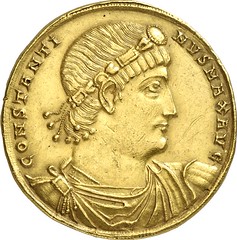
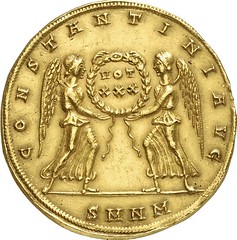
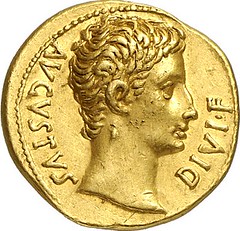
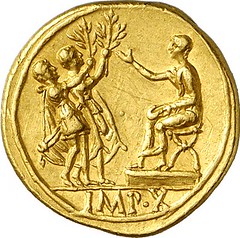
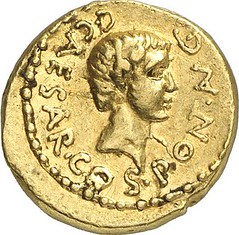
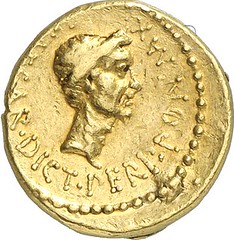
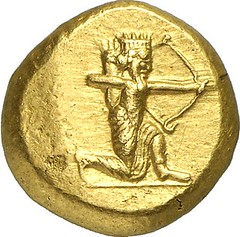

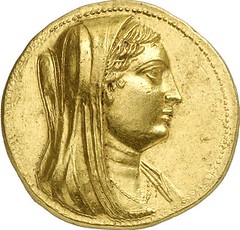
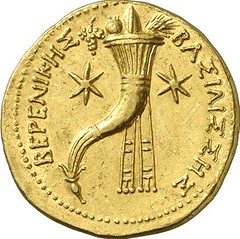

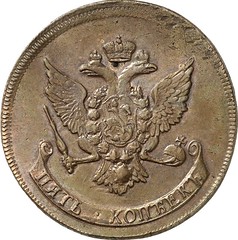
To visit the Gorny & Mosch site, see: www.gmcoinart.de

THE STORY OF THE PRINCE GEORGE CHRISTENING COIN
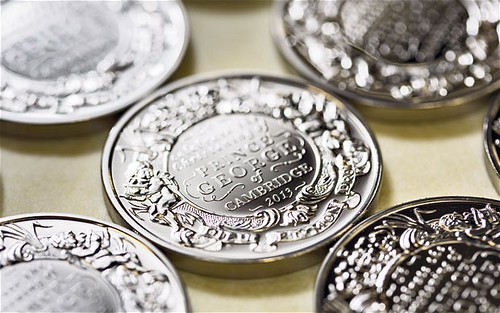
The birth of Prince George of Cambridge signals the beginning of a new generation of the modern British monarchy. Not yet three months old, he is already commanding unprecedented affection – this is the first time that commemorative coins have been produced to mark a royal christening.
Of all the new coins, one stands out. Roughly the size of a saucer, it is made of a kilogram of solid gold and is worth £50,000. This is one of the largest and most expensive coins that the Royal Mint has ever produced. Just 22 are available to buy.
“None of the coins I engrave are ‘just another job’,” says Gordon Summer, 47, the chief engraver at the Royal Mint. “But this is particularly auspicious. There are a number of things I’ve done that I’m proud of, but this one tops them all.”
Although the Royal Mint machines normally produce 3,000 coins per hour, such is the intricacy of this design that only 100 can be produced in the same amount of time.
The coins were designed by John Bergdahl, 65, who has been an engraver for 40 years. He was one of five artists invited to submit designs to the Royal Mint Advisory Committee, which is chaired by Lord Waldegrave, provost of Eton College. Bergdahl’s design was the favourite from the start.
“It was a complex job as I had so little to go on,” he says. “I didn’t know the name of the baby, when it would be born or the gender. I was looking for inspiration and found an image of a silver gilt baptismal font which was commissioned by Queen Victoria in 1840 in anticipation of her first child, Victoria Adelaide Mary Louisa. It has been used to christen every royal baby since, and is kept in the Tower of London with the Crown Jewels. I took the wonderfully intricate decoration on the font and applied it to the dimensions of a coin.”
The design features a pair of cherubs, an ornate cartouche supported by a lily, and a coronet befitting the heir to the throne, as well as a scroll bearing the royal motto, Dieu et mon droit.
The font, which was crafted by the silversmiths E & W Smith, was inspired by the Baroque style, which was noted for its symmetry and flamboyance. By coincidence, Bergdahl explains, the style was popularised in the early 18th century – by a certain King George I. “It fitted so well,” he says. “It was very fortuitous indeed.”
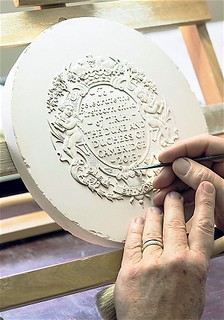 Once the design was approved, Bergdahl made a plaster-of-Paris version. This was scanned in three dimensions into a computer and imprinted into a steel stamp using a laser. But the process is far from fully automated.
Once the design was approved, Bergdahl made a plaster-of-Paris version. This was scanned in three dimensions into a computer and imprinted into a steel stamp using a laser. But the process is far from fully automated.
“Once we had the steel stamp, we had to return to hands,” says Summer. “The quality downgrades when it goes through a computer, and it’s not good enough for us. Every detail needs to be absolutely perfect, and that can only be achieved by hours of delicate carving using an eye-lens and a variety of hand tools.”
To read the complete article, see: The story of the Prince George christening coin (www.telegraph.co.uk/news/uknews/prince-george/10377085/The-story-of-the-Prince-George-christening-coin.html)
THE ROYAL MINT MUSEUM
It’s hard to be brief about the treasures held safely for the nation behind the anonymous door that opens to The Royal Mint Museum, but I’m going to try, so here are some snippets:
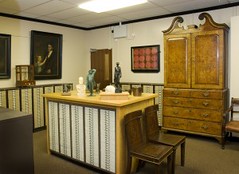 The Museum holds a cabinet said to be Sir Isaac Newton’s cabinet when he was Master of the Mint from 1699-1727; pistols from the Tower of London that provided the security of those times and literally thousands of coins from all over the world. Plasters of coins and medals from the late 19th Century, wax impressions of the Great Seals of the Realm and other official Seals from the start of the 20th century, are all preserved here.
The Museum holds a cabinet said to be Sir Isaac Newton’s cabinet when he was Master of the Mint from 1699-1727; pistols from the Tower of London that provided the security of those times and literally thousands of coins from all over the world. Plasters of coins and medals from the late 19th Century, wax impressions of the Great Seals of the Realm and other official Seals from the start of the 20th century, are all preserved here.
One of the great treasures, the Waterloo Medal Roll, lists the names of all those who fought at the Battle of Waterloo. Medal-making is an area of our work that is perhaps not very well-known. It began here in 1817 when we made the Waterloo Medals, and continues to this day with production of medals for the Armed Forces and many other organisations.
However, not all the treasures are locked away in the Museum. Around us on site are historic items brought to Llantrisant from our previous homes at the Tower of London and Tower Hill. Here are the ones that impress me most:
A Royal Mint Seal made by engraver John Croker in about 1709 is part of a small foyer exhibition and, although not ancient, the plaster of the Great Seal of the Realm, created in 2000 by James Butler RA, hangs in the Board Room as its artwork is so well-regarded.
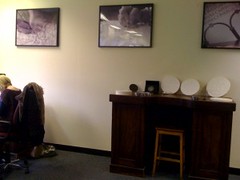 Our talented Designers and Engravers say they take daily inspiration from an antique desk that sits in their work-room. Legend has it that was used by Benedetto Pistrucci, the Italian artist responsible for the famous 1817 ‘St George and the Dragon’ design on Sovereign coins.
Our talented Designers and Engravers say they take daily inspiration from an antique desk that sits in their work-room. Legend has it that was used by Benedetto Pistrucci, the Italian artist responsible for the famous 1817 ‘St George and the Dragon’ design on Sovereign coins.
To read the complete article, see: Life Inside The Royal Mint – History & treasures surround us! (blog.royalmint.com/life-inside-the-royal-mint-history-treasures-surround-us/)
MEDIEVAL INSTITUTE PUBLICATIONS SEEKS MANAGING EDITOR
Dennis Tucker writes:
Western Michigan University’s Medieval Institute is seeking a managing editor / director for its publishing arm, Medieval Institute Publications. This might be something an E-Sylum reader would be interested in, either for their own career path or for a friend. The icing on the cake: the position is located in historic Kalamazoo, home of award-winning numismatologist Joel Orosz! Here’s the job description:
Medieval Institute Publications, the publishing arm of the Medieval Institute of Western Michigan University, seeks an experienced scholarly publishing professional to fill the position of managing editor/director. The ME/DI is responsible for the administration and development of all aspects of our publishing operation, including acquisitions and list development, budgeting, marketing, production, promotion, and staff management. S/he is a senior administrative officer of Western Michigan University and reports to the Director of the Medieval Institute.
The ME/DI is expected to enhance the national and international reputation of Medieval Institute Publications, to expand our strong and diverse list in Medieval Studies, and to lead in the use of innovative information technologies and electronic publishing. S/he will lead a staff of three full-time professionals (production editor/designer, editor/Congress book exhibit coordinator, and order fulfillment manager) as well as graduate student assistants and independent contractors, to represent Medieval Institute Publications both within the university and externally, and to supervise the business operations of a small, specialized publisher.
The managing editor must have excellent communications skills, experience in the field of Medieval Studies, a minimum of seven years of experience in scholarly publishing (including experience in electronic publishing), and an advanced degree in the humanities.
Joel Orosz writes:
Western Michigan University received a huge Cistercian library back in the 1960s; founded the medieval Institute in 1973; and has hosted the annual International Congress of Medieval Studies meetings ever since. A number of the sessions every year are numismatic in nature, and the American Numismatic Society sends a contingent to Kalamazoo without fail. When I've attended, I've mainly pretended that I understand the abstruse issues around medieval coinage, but those who know what they are doing find these presentations to be top-of-the-line.
WMU is a dynamic and growing university of 25,000 students, located cheek-by-jowl with my alma mater, Kalamazoo College (1800 students), one of America's premier liberal arts colleges. Kalamazoo is obviously a college town, but it is also a medical mecca, being the headquarters of the Fortune 500 companies like Upjohn (now a major manufacturing and research hub of Pfizer), and Stryker Corporation, maker of medical devices. These tie in nicely with Western's med school and with two major medical centers, Bronson and Borgess, both nationally ranked in key specialties, such as obstetrics and cardiology.
Kalamazoo is nationally recognized for the Kalamazoo Promise, which guarantees four years of college tuition to all graduates of the Kalamazoo Public Schools. Kalamazoo. population in about 80,000, while another 40,000 live in its largest suburb, Portage. Finally, Kalamazoo's location on I-94 is almost exactly halfway between Chicago and Detroit--2.5 hours away from either the Loop to the west or from Comerica Park to the east, where you can watch the Tiger annual postseason collapse. The Tigers could have signed, many years ago, a young prospect from Kalamazoo named Derek Jeter, but nooooo....
To vist the Western Michigan University web site, see: www.wmich.edu
EBAY UNVEILS COLLECTIONS FEATURE
- Collections—groups of products that have been handpicked from eBay's more than 500 million listed items by expert curators, eBay members, and sellers
- Curators—top trendsetters across a variety of interest areas, who create beautiful collections on eBay to help easily connect you with items you'll love
- Follow—a simple, one-click way for you to personalize your feed by following the collections, curators, eBay members, and interests that inspire you
- Profiles—a customizable page for you to share information about yourself, the collections you've created, and the interests, collections, and people you follow
- eBay Today—a new page that helps you easily discover the very best collections of items on eBay, selected daily by our Chief Curator
These features have been specifically designed to enhance and inspire your shopping experience, helping you explore and discover products that you're passionate about every day. The more people or collections of products you choose to follow, the more personal and dynamic your feed becomes, creating an ever-changing selection of products that match your interests.
I'd like to personally invite you to explore these new features, to follow the incredible collections from our curators and eBay members, to tap into your passions and create collections of items for others to explore, and to connect with all of the things you need and love.
Best,
Devin Wenig
President, eBay
 To view some eBay Collections, see:
Collections matching "coins"
(www.ebay.com/cln#{"keyword":"coins"})
To view some eBay Collections, see:
Collections matching "coins"
(www.ebay.com/cln#{"keyword":"coins"})
Coinfacts Featured US Classic Coins
(www.ebay.com/cln/blutosports/Coinfacts-Featured-US-Classic-Coins/58109356012)
Army Challenge Coins
(www.ebay.com/cln/tm5145/Army-Challenge-Coins/57634862012)
crowns
(www.ebay.com/cln/julior414/crowns/54614619010)
medallic art
(www.ebay.com/cln/houseofcheese/medallic-art/53791027010)
THE BOOK BAZARRE
SQUARE LAUNCHES SIMPLE CASH PAYMENTS SERVICE
 Square officially took the wraps off its planned peer-to-peer payments service Square Cash today, and the results are quite impressive — it isn’t just creating a PayPal clone. It’s streamlined the transaction to a bare minimum of two elements: both the payer and payee connect with an email address and a debit card.
Square officially took the wraps off its planned peer-to-peer payments service Square Cash today, and the results are quite impressive — it isn’t just creating a PayPal clone. It’s streamlined the transaction to a bare minimum of two elements: both the payer and payee connect with an email address and a debit card.
Here’s how it works: A payer simply creates an email from any mobile, web or PC client with the email address of the payee in the “To” line, cash@square.com in the “CC” field and the dollar amount in the subject. Then the payer hits send. That’s it.
If the payee is already a Square Cash customer then he or she will receive the email notification and find the money transferred from the payer’s bank account in one or two business days. If either the payee or the payer — or both — aren’t yet Square account holders, then they would receive registration prompts asking them to enter their bank debit card numbers. Once that number is entered, their debit accounts will become automatically linked to their email addresses through Square. All further transactions require nothing more than sending and receiving email.
When Square decided to create this service it wanted to replicate the same simplicity of design and ease of use of its other payment products, said Brian Grassadonia, head of Square’s Cash team. That meant it wanted to strip out all of the steps that complicate other peer-to-peer payments services: no multiple verification steps, no entering checking account and routing numbers, no passwords and — most significantly — no need for a separate financial account to act as repository for all transactions. With Square’s approach, the consumers use the basic financial and online tools they already have, Grassadonia said.
Of course, the simpler a payment’s design, the more prone it is to abuse — in this case getting access to a consumer’s checkbook would as easy as hacking an email account. Grassadonia said Square is putting the same fraud prevention tools in place it uses to secure its business mobile payments networks. The first line of protection is an SMS alert system that notifies an account holder any time a payment is received or sent, giving the user the opportunity to suspend transactions. Square is also imposing a $2,500 limit per week on transactions.
To read the complete article, see: Square launches Cash, a peer-to-peer payments service that’s incredibly simple to use (gigaom.com/2013/10/15/square-launches-cash-a-peer-to-peer-payments-service-thats-incredibly-simply-to-use/)
HARVEY FRYER MEETS ARTHUR BRADEN COOLE
I attended Baker University in Baldwin City, Kansas. Then, I was much too involved with studying to have any time to collect or to even think about coins. I was living with a group of students who were of Chinese origin and who came from countries that became known as Malaysia.
In those days I became very interested in learning Chinese but had little time to do so. One day I was walking downtown and I looked in the window of a TV repair shop and saw a string of Chinese cash. I went in and asked him about the coins. He had taken the coins in exchange for a TV repair. I bought the coins and started to stack them by reign titles. I knew next to nothing about them. One day I dropped by the TV shop and the guy told me he was going to retire and that he was willing to tell me where he got the coins.
When I told my roommates the name of the person, they all told me that they knew him. He had met them when they came from abroad. He would always meet the Chinese speakers when they came to the school. This was Arthur Braden Coole. He and his father had both been missionaries in China. Authur Braden Coole’s father had in fact donated his Chinese collection to the school I was going to.
Eventually I got the courage to go see Mr. Coole. I really do not remember much of what was said but, I ended by buying one of his books (he autographed it with his Chinese name) and several coins. The ones I remember best were a couple of circulated coins with a peacock on them, a very large 50 cash coin from the Xienfeng (Hsien Feng—咸豐) ) emperor, several one yen pieces from the Meiji era that looked as if they were in circulation for a short time only, an 8 Reales piece that was chopped so badly it was cupped, and two 50 sen pieces from the Meiji era that were also cupped because of the numerous chops. Prior to the time Mr. Coole sold me these coins he had sold most of his Chinese collection.
One day I met someone at a coin show who was selling chopped coins. He told me most collectors thought chopped coins were dam-aged and they did not want to buy them. I bought 7 or 8 chopped coins from him. I primarily picked coins with a few chops in the fields and from different countries. I liked ones with the Chinese characters the most.
Later I discovered the existence of the Chopmark News and started to look at the chopped coins and some of the Chinese coins I had previously purchased. I found that I had several interesting chopped coins that I had purchased from Authur Bradden Coole many years before. I also, eventually, checked a purchase I made at one of the Long Beach shows- a 50 Cash copper Xien-feng cast coin that I finally realized had chops.
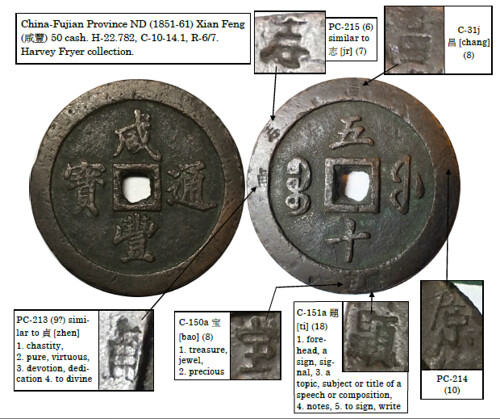
For more information on the Chopmark Collectors Club, see: http://chopmarks.org
BASQUIAT PAINTING OF JEFFERSON NICKEL UP FOR AUCTION
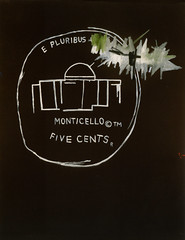 Ladies and gentlemen, the time has come for another painting by meteoric art icon Jean-Michel Basquiat to hit the auction block. The unusual, and largely unseen, work, entitled "Monticello," depicts the white outline of a nickel against a black background, depicted in Basquiat's typical street-inspired scribble. But the going rate for this five cent coin is a bit more than you'd expect -- the pricey work is set to fetch a cool $1,242,000.
Ladies and gentlemen, the time has come for another painting by meteoric art icon Jean-Michel Basquiat to hit the auction block. The unusual, and largely unseen, work, entitled "Monticello," depicts the white outline of a nickel against a black background, depicted in Basquiat's typical street-inspired scribble. But the going rate for this five cent coin is a bit more than you'd expect -- the pricey work is set to fetch a cool $1,242,000.
"Monticello" was created in 1986, only two years before Basquiat's untimely death at 27 years old after overdosing on heroine. The piece, although less busy than his more well-known graffiti-swamped canvasses, weaves together diverse influences and styles in Basquiat's signature fashion. The young artist possessed a great talent for seamlessly folding together racial, political and economic references in a whirring visual language simultaneously naive and complex.
The painting depicts a U.S. five cent coin, circling around Monticello, the Virginia home of Thomas Jefferson, a stronghold of the slave trade. The image blatantly references the racist foundations of our country as well as Basquiat's personal narrative growing up as a black artist under economic hardship. He was a homeless teen before blowing up into art superstardom.
On the top of the coin reads "e pluribus unum," or "out of many, one," yet the last word has been scratched out. The erasure of the "unum" could point out the lack of truth in the common mythology of the United States' unity, or it could extend to Basquiat's multidimensional aesthetic, which erases the possibility of a singular meaning in favor of endless multiplicity. Though the piece might look simpler than Basquiat's more universally known paintings, there are enough meanings, influences and visual styles to keep you wrapped up in the work for days.
"Monticello" heads to auction as part of the Urban Contemporary Art Sale, hosted by Digard Auctions and Mary McCarthy, on October 25 at the Hotel Drouot in Paris. The work is expected to go for around $1.2 million, which isn't that bad considering two Basquiat paintings just sold for $4.3 million and just under $5 million at Frieze in London.
To read the complete article, see: Rare Basquiat Painting 'Monticello' Poised To Make $1.2 Million At Auction (www.huffingtonpost.com/2013/10/25/basquiat-monticello_n_4157569.html)
WE'RE OUT OF QUARTERS
On a busy Friday night at the restaurant where I'd recently started waiting tables, the owner suddenly emerged from the kitchen and handed me money. "We're in trouble!" He said. "We're out of quarters, and customers are waiting. Go next door and get me $40 worth."
I ran to the supermarket next door, but a cashier said she wasn't allowed to give out that many quarters. Determined, I sprinted to a convenience store two blocks away, but it was closed. At a gas station farther down the road, the clerk took pity and gave me the four rolls of quarters. Twenty minutes after I'd left, I handed the coin rolls to my boss. "Where are the quarters?" He asked.
"Right here," I said breathlessly.
His face sank. "I meant chicken quarters."
To read the complete article, see: Out of Quarters (www.gcfl.net/archive.php?funny=20131021)
CLEANERS DISCOVER 280 GOLD BARS IN AIRPLANE TOILET
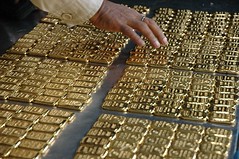 Cleaners have discovered 280 gold bars worth £1.17million inside a plane's toilet at an airport in Bangladesh.
Cleaners have discovered 280 gold bars worth £1.17million inside a plane's toilet at an airport in Bangladesh.
Armed police were called on board the plane which had flown from Dubai to Hazrat Shahjalal International Airport in Dhaka where they recovered the gold weighing about 32kg.
Cleaners stumbled across the bullion when they were cleaning the plane's bathroom.
Custom officials said they knew the bars were on board and believe the person carrying them sensed there was a police presence and abandoned the gold in the toilet of the aircraft before fleeing the scene.
To read the complete article, see: Panning for gold: Cleaners discover 280 ingots worth £1.17million inside plane's toilet (www.dailymail.co.uk/news/article-2471825/Gold-planes-toilet-worth-1-17m.html)
TOILET PAPER MADE OF GOLD. REALLY
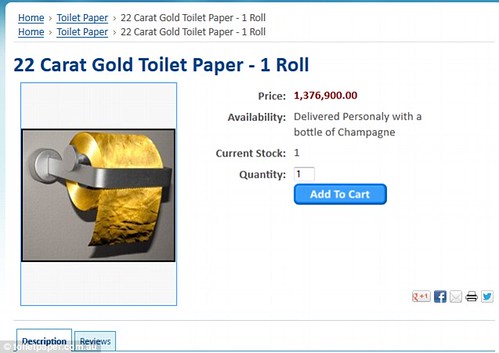
There seems to be no limit to the extremes people will go to show off their wealth. And now, for those who truly want to wow guests - or simply want to flush some excess money down the loo, there is...gold toilet paper.
The roll, sold by Australian company the Toilet Paper Man is made from 22-carat gold and costs a staggering $1,376,900.00 (around £825,839).
The website claims that each roll - which comes with a free bottle of champagne - will be delivered personally.
And for those concerned that metal may not provide a gentle wipe, the roll is three-ply to ensure the utmost comfort.
Speaking to the Mail Online, the company said the inspiration for the roll came from Dubai.
'When we saw in Dubai some hotels have full gold toilet seats and handles for the toilet paper we decided it would be a good idea.
To read the complete article, see: Loo paper made of 22-carat GOLD goes on sale at £825k for those who fancy throwing their money straight down the toilet (www.dailymail.co.uk/femail/article-2471446/Loo-paper-22-carat-GOLD-goes-sale-825k.html)
FEATURED WEB PAGE: GLOSSARY OF ERROR-VARIETY TERMS
This week's Featured Web Page is the Glossary of Error-Variety Terms from the web site of the Combined Organizations Of Numismatic Error Collectors of America (CONECA)
Abnormal reeding
This coin was struck from a collar die, which had either more than or less than the normal number of reeds. One of the most well-known examples is the 1921 Morgan dollar, which exhibits infrequent reeding.
Abrasion doubling
These coins were struck from dies that have been heavily abraded. The abrasion could have occurred inside the cavities of the design, including letters and digits. Such coins appear to have overlapping or doubled design elements. The abrasion could have occurred on the outside edges of the design, including letters and digits. The doubling is most commonly seen between the letters or digits and the rim. The best examples are the “poor man's double dies” of 1955. These coins are NOT the product of hub doubling and carry little, if any, premium. Abrasion doubling is a very common occurrence, especially on recent coinage. Thus it has little collector interest or value. Also see Die Deterioration Doubling.
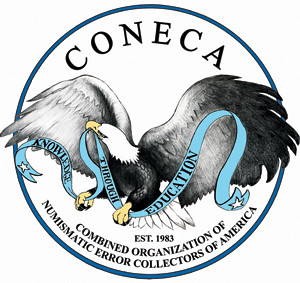
conecaonline.org/content/glossary.html
